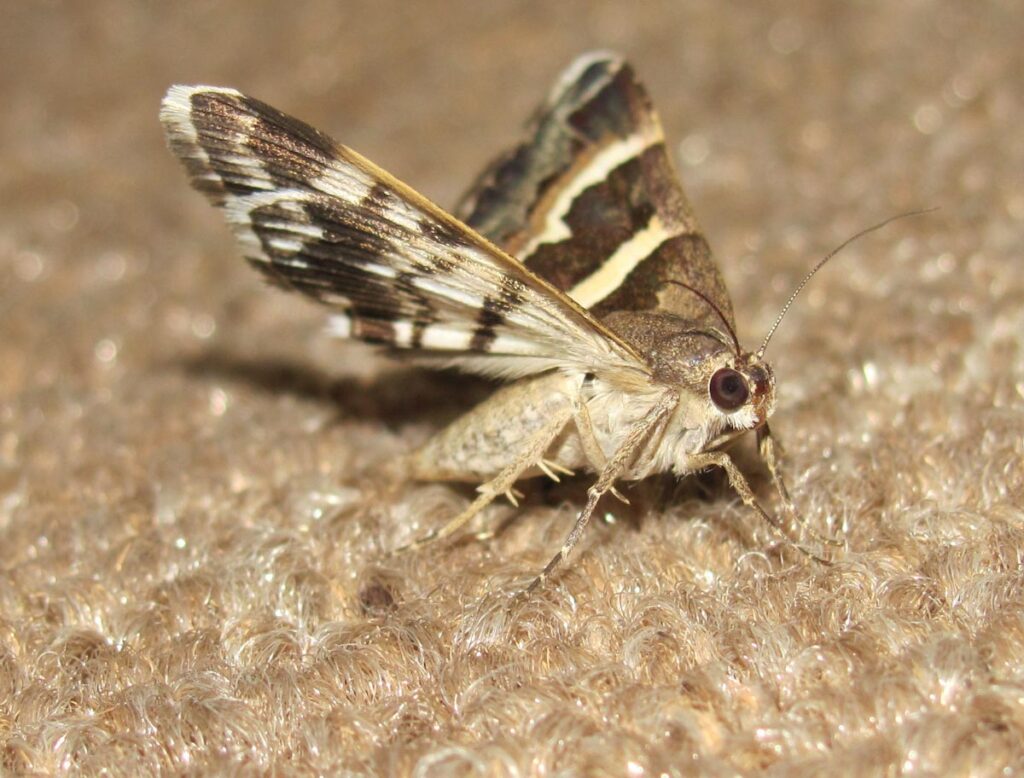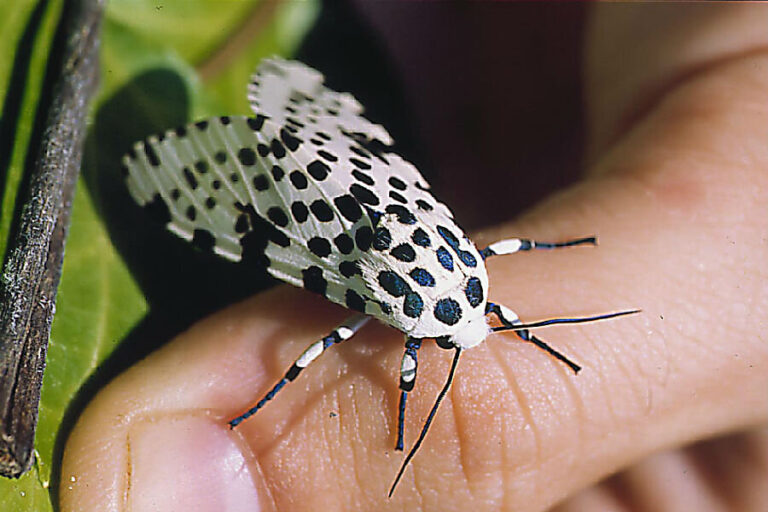No, moths cannot make you blind. Moths are insects, and they do not possess the capability to cause blindness in humans. While moths are attracted to light sources and may fly near your eyes if you are using a light in the dark, they do not have any mechanisms to intentionally harm humans or cause damage to the eyes.
However, it’s essential to remember that certain insects, such as mosquitoes or flies, can carry diseases that might affect human health if they bite or come into contact with a person. But the act of a moth flying near your eyes is not a cause for concern regarding your eyesight or health.
How do moths behave around light sources?
Moths are insects belonging to the order Lepidoptera, which also includes butterflies. They are characterized by their scaly wings and typically nocturnal habits.
Moths come in various shapes, sizes, and colors, with some species displaying intricate patterns on their wings.
Most moths have antennae that are feathery or filamentous, which aid in detecting pheromones and other chemical signals.
Moth Attraction to Light Sources

Moths are often attracted to light sources, a behavior known as phototaxis.
Furthermore, this attraction to light can vary among species, but it is a common phenomenon observed in many moth species.
The reason for this behavior is not entirely understood, but several theories exist. One popular theory suggests that moths mistake artificial lights for celestial objects like the moon or stars, which they use for navigation.
Another theory is that moths use light sources for orientation during their nighttime flights, and they get disoriented when they fly too close to the light.
Lack of Harmful Mechanisms in Moths
Moths are generally harmless to humans. They do not have harmful mechanisms like stingers or venomous bites.
Unlike some other insects, moths do not possess the ability to transmit diseases to humans through biting or contact.
Moths do not have any specialized tools or adaptations for causing harm to humans or animals. They primarily feed on nectar, pollen, or, in the larval stage, on plant material such as leaves.
While moths may occasionally land on people or objects, they are not equipped to inflict any harm beyond minor inconvenience or surprise.
What factors affect eye health?
Understanding the structure and function of the human eye, as well as the factors that can affect eye health, is crucial for maintaining good vision and preventing potential issues.
Anatomy of the Eye: The human eye is a complex organ responsible for vision. It consists of several key components, including the cornea, iris, pupil, lens, retina, and optic nerve.
Furthermore, the cornea is the clear, outermost layer that protects the eye and helps focus light.
The iris controls the amount of light entering the eye through the pupil, which is the black, central part of the eye. In addition, the lens focuses light onto the retina, which contains specialized cells called photoreceptors (rods and cones).
Vision Process : Light enters the eye through the cornea and pupil. The lens then adjusts its shape to focus the incoming light onto the retina.
Photoreceptors in the retina convert light into electrical signals. These signals are transmitted via the optic nerve to the brain, where they are processed to create visual images.
Functions of the Eye :
The eye allows us to perceive and interpret the world around us by capturing and processing visual information. Cones in the retina are responsible for color vision and detail, while rods are more sensitive to low light and motion.
Discussion of Factors That Can Affect Eye Health
Age-Related Changes: As people age, the eye undergoes natural changes, including a gradual decline in the flexibility of the lens (presbyopia).
Age-related conditions like cataracts (clouding of the lens) and macular degeneration (damage to the central part of the retina) can affect vision.
Environmental Factors: Prolonged exposure to ultraviolet (UV) radiation from the sun can contribute to eye conditions like cataracts and pterygium.
Excessive exposure to blue light from digital screens may cause eye strain and disrupt sleep patterns.
Infections and Diseases: Eye infections like conjunctivitis (pink eye) and keratitis can cause redness, irritation, and vision problems if left untreated.
Chronic conditions like glaucoma (elevated intraocular pressure) and diabetic retinopathy (damage to blood vessels in the retina) can lead to vision loss if not managed properly.
Injuries and Trauma: Physical injuries to the eye, even minor ones, can result in vision problems or permanent damage.
Protective eyewear is crucial in sports and activities where eye injuries are a risk.
Genetic Factors: Some eye conditions, such as myopia (nearsightedness) and retinitis pigmentosa (a rare inherited disorder), have a genetic component.
Nutrition and Lifestyle: A balanced diet rich in vitamins and minerals, especially vitamin A and antioxidants, can support eye health.
Smoking and excessive alcohol consumption can increase the risk of eye problems.
Regular Eye Examinations:
Routine eye check-ups are essential for early detection and management of eye conditions.
Many eye conditions, including glaucoma, can be asymptomatic in the early stages.
How do certain insects transmit diseases?

Understanding the specific behaviors and biology of different insect species can help differentiate between those that pose health risks and those that do not.
Mention of Diseases Transmitted by Certain Insects
Mosquitoes: Mosquitoes are well-known vectors for several serious diseases, including malaria, dengue fever, Zika virus, and West Nile virus.
Malaria, caused by the Plasmodium parasite, is one of the deadliest mosquito-borne diseases, responsible for hundreds of thousands of deaths annually.
Dengue fever and Zika virus can lead to severe illness, birth defects (in the case of Zika), and even death.
Ticks: Ticks can transmit Lyme disease, which is caused by the bacterium Borrelia burgdorferi.
Lyme disease can result in a range of symptoms, including fever, joint pain, and neurological issues, if not treated promptly.
Fleas: Fleas can transmit diseases like bubonic plague, caused by the bacterium Yersinia pestis. While bubonic plague is rare in modern times, it has historically caused devastating pandemics.
Sandflies: Sandflies are responsible for transmitting a parasite called Leishmania, which causes a group of diseases known as leishmaniasis.
Leishmaniasis can manifest in different forms, including skin lesions, mucosal damage, and a severe systemic illness called visceral leishmaniasis.
Emphasis That Moths Are Not Known to Transmit Diseases
It’s essential to clarify that moths are not known to transmit diseases to humans or other animals. Unlike some other insects, moths do not bite, sting, or carry pathogens that can infect humans.
Moths primarily feed on nectar, pollen, or plant material, and their mouthparts are adapted for this type of feeding. They lack the specialized mouthparts or mechanisms that blood-feeding insects like mosquitoes, ticks, and fleas have developed to transmit diseases.
Additionally, moths are generally harmless and do not pose a threat to human health in any way beyond occasional annoyance due to their attraction to light sources. Their interactions with humans are typically brief and benign.
While it’s important to take precautions against insect-borne diseases when necessary, there is no need to be concerned about moths as disease vectors.
FAQ’s
Can moths hurt your eyes?
No, moths cannot hurt your eyes. They lack the physical attributes to cause harm to your eyes or any intentional harmful behavior towards humans.
Is moth dust harmful?
Moth dust, which consists of tiny scales from a moth’s wings, is not inherently harmful to humans. However, inhaling large quantities of moth dust may irritate the respiratory system for some individuals with allergies or sensitivities.
Can moths be blind?
Moths do not possess eyesight in the same way humans do. They have simple eyes called ocelli that detect light and darkness, but they do not have the complex vision systems that would be subject to blindness as we understand it.
What is moth vision like?
Moth vision is relatively simple compared to human vision. They use their compound eyes and ocelli to detect light and dark, but they do not perceive details or colors in the same way humans do. Moths primarily rely on other senses, such as smell and touch, for navigation and survival.
Is a moth in your room bad?
Having a moth in your room is generally not a cause for concern. Moths are harmless to humans and do not pose any immediate threat. They are usually attracted to light sources and may enter buildings unintentionally.
Are moths good luck?
In some cultures, moths are considered symbols of transformation and rebirth, which can be interpreted as bringing good luck. However, beliefs about the luck associated with moths vary, and it is not a universally held belief.
Final Words
In conclusion, moths cannot make you blind or cause harm to your health. Moths are just little creatures that like to flutter around lights sometimes, but they don’t have anything dangerous to hurt us.
Our eyes are precious, and we need to take care of them by protecting them from real threats like UV rays, injuries, or infections. Some insects like mosquitoes or ticks can spread diseases, but moths are not one of them.
So, if you see a moth flying near you, don’t worry about your eyesight. Just let it do its thing, and you’ll be just fine. Remember, it’s important to learn about different insects and their behaviors to stay safe and healthy.

